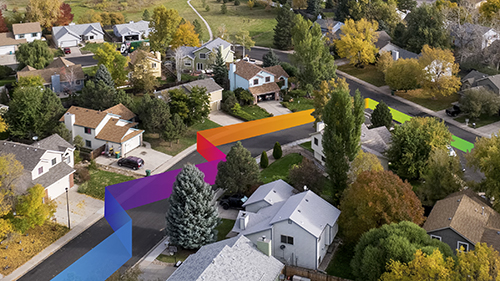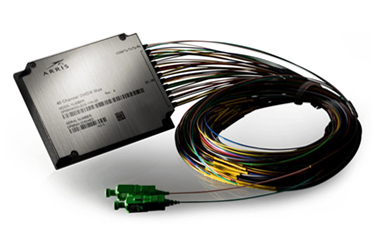Evolution and Revolution: The DOCSIS® 4.0 Network
DOCSIS® 4.0 is the new, ground-breaking iteration of DOCSIS. DOCSIS 4.0 expands operation in the HFC cable access network to up to 1.8 GHz in the downstream and up to 684 MHz in the upstream. This increased spectrum supports noticeably higher speeds and capacities than earlier iterations of DOCSIS.
DOCSIS 4.0 is unique because it supports both evolutionary and revolutionary network options. For example, you can evolve a traditional HFC cable access network architecture with Extended Spectrum DOCSIS (ESD) or Full Duplex DOCSIS (FDX) technologies, which use traditional HFC actives and passives to either expand or optimize bandwidth capacities. Or you can revolutionize your network with a DOCSIS 4.0 Distributed Access Architecture (DAA) or Node PON deployment.
Whichever path to DOCSIS 4.0 fits your upgrade plans, CommScope® has a full range of DOCSIS 4.0 products and solutions to choose from.

The Evolutionary Network: ESD and FDX
CommScope supports both Extended Spectrum DOCSIS (ESD) and Full Duplex DOCSIS (FDX), the two primary DOCSIS 4.0 options for evolving HFC Cable Access Networks. Both options offer unique advantages that support a wide range of network upgrade scenarios.
An ESD network extends the operating spectrum to 1.8 GHz in the downstream and up to 684 MHz in the upstream. ESD networks retain the traditional separation between upstream and downstream bands via frequency-specific diplex filters in amplifiers and nodes. ESD operation requires:
- Nodes, amplifiers, booster amplifiers (in certain operating scenarios), and taps/passives that support 1.8 GHz operation
An FDX network uses a traditional 5-85 MHz mid-split upstream band and a maximum downstream band of 1.2 GHz. But in FDX operation, there’s a shared portion of the upstream and downstream spectrum that begins at 108 MHz and extends to 684 MHz. FDX operation uses this shared spectrum dynamically by “directing” portions of it toward the upstream or downstream band based on traffic demands. The “overlap” between the upstream and downstream bands is possible because of Echo Cancellation (EC), which dramatically reduces the interference between upstream and downstream transmission, allowing for shared bandwidth transmission. This shared transmission is used to increase the bandwidth for the upstream signal. FDX operation requires:
- Nodes and amplifiers that support 1.2 GHz FDX operation
- 1 GHz or 1.2 GHz Taps/passives do not need be replaced, since FDX operates at a maximum downstream bandwidth of 1.2 GHz
You can typically upgrade your currently installed base of CommScope 1 GHz and 1.2 GHz STARLINE® amplifiers, NC4000® Series nodes, and OM4 Series nodes for 1.8 GHz operation, which helps mitigate some of the costs associated with DOCSIS 4.0 network upgrades. You can also upgrade CommScope 1 GHz and 1.2 STARLINE amplifiers for FDX operation.
The Revolutionary Network, Part 1: DAA
DAA technology leverages your existing HFC cable access network architecture to remake and redeploy the edge of your network by replacing traditional optical modules in an access node with an RxD module. DAA eliminates traditional headend optics, using instead a virtualized, decentralized approach that replaces analog fiber technology with IP-based transport over digital fiber links. Analog headend links are also replaced in favor of a digital fiber Ethernet link, which increases available bandwidth by expanding the number of available wavelengths that can be used in the network.
The result? A software-defined, potentially all-fiber network that can speed the transition from your traditional, coaxial-based HFC network architecture, provide better spectral efficiencies, and improve your network’s overall performance. Other DAA benefits include:
- Enhanced performance via digital Ethernet links
- Migration to centralized data centers
- Flexible advertising, channel lineups, and bandwidth management
DAA networks use one of two approaches at the edge of the network. Remote PHY (R-PHY) operation moves DOCSIS signal generation out of the headend and into a Remote PHY Device (RPD) located in an access node.

Typical R-PHY Network Architecture
Remote MACPHY (R-MACPHY) does the same for DOCSIS signal generation and processing.

Typical R-MACPHY Network Architecture
Which DAA solution you select will depend on several factors, primarily centered around cost of deployment, the extent to which the solution supports virtualization, and which solution is the best fit for your network. Both R-PHY and R-MACPHY operation, however, share significantly greater operational flexibility and scalability than traditional HFC cable access network architectures.
The Revolutionary Network: Part 2: Node PON
Node PON supports both full fiber operation and selective deployments that supplement your existing HFC cable access network with a cloud-to-edge approach that lets you choose between an EPON network—which requires minimal changes to your headend and CPE architecture—or a GPON network, which maximizes network performance and restructures your back-office infrastructure .

Typical Node PON Network Architecture
CommScope’s node-based approach maintains DOCSIS provisioning compatibility with 10G EPON. Node PON can also utilize XGS PON—with SDN-based Domain Management—for network provisioning and telemetry gathering. Both approaches provide a seamless and efficient way to drive fiber deeper into your network, and they can reduce the energy, maintenance, and operational requirements of your traditional headends.
CommScope’s R-OLT device supports both leading PON technologies: IEEE EPON/10G EPON and ITU GPON/XGS-PON. Fully compliant with CableLabs® DPoE v2.0 standards, IEEE EPON/10G EPON can operate on your current CPE and headend architecture with minimal changes, reducing your cost of deployment. ITU GPON/XGS-PON operates from a cloud-based PON domain manager that supports platform interoperability for provisioning, ONU management, zero-touch on-boarding, and provisioning speeds deployment.
You can choose either PON technology to evolve your existing Brownfield networks or expand your network via a Greenfield build.
Revolutionizing the Headend: Virtual vCCAP and vBNG Evo™
Revolutionary DAA and Node PON networks push traditional headend or central office processing to the edge of the network. In DAA networks, this means moving DOCSIS signal generation (Remote PHY, or R-PHY) or DOCSIS signal generation and processing (Remote MACPHY, or R-MACPHY) out of the headend and into a module in an access node. In Node PON operation, the Optical Line Terminal (OLT) is moved out of the central office into a module in an access node or virtual hub. Virtualized headend operation significantly improves network capacity, lowers operating costs, speeds time to market, and supports the seamless provisioning and configuration of devices.
vCCAP Evo
CommScope’s DAA solutions are supported by vCCAP Evo, a virtualized, cloud-native Converged Cable Access Platform that fully supports legacy I-CCAP functionality. vCCAP Evo runs off commodity x86 servers that you can locate at centralized and/or distributed locations. This approach enables you to deploy a hybrid configuration in which both the vCCAP Evo and your legacy I-CCAP operate together, so you can smoothly transition to full virtualized operation at your own pace.
vCCAP Evo simplifies DAA operation by supporting the disaggregation and reallocation of functions. You can therefore initiate DAA operation with Remote PHY but later switch to Remote MACPHY operation if, for example, you need to retire aging headends. vCCAP Evo’s support for CableLabs’ YANG models, which enable third party solutions to provision and monitor DAA nodes, helps to further simply your transition to DAA operation by leveraging your existing network assets. Additionally, vCCAP Evo’s container-based design scales easily to support any number of RPDs as you expand your DAA deployments.
vBNG Evo
vBNG Evo, a virtualized Broadband Network Gateway router, is a cloud-native platform for both Open Stack and container-based cloud networks. The vBNG Evo acts as the access point for broadband subscribers, connecting CPE devices in the home to either the Network Service Provider (NSP) or Internet Service Provider (ISP) and establishing and managing subscriber sessions. The vBNG features a unique design that disaggregates network functions, streamlines packet flows, and enables independent, dynamic scaling of control and data planes. Used in conjunction with a node-based R-OLT device, the vBNG Evo provides you with the performance, scaling, and flexibility you need to virtualize the delivery of high-speed data, voice, and video to broadband subscribers.
vBNG Evo eliminates the need for Broadband Remote Access Servers (BRAS) and legacy BNG chassis. The vBNG Evo’s disaggregated architecture enables you to distribute data planes to remote central offices closer to subscribers’ locations while keeping the data plane at a data center or regional central office. This design also supports independent scaling of the control and data planes, with the data plane scalable to Tbps and the control plane scalable from 256, 000 to five million. The result is more flexible and efficient than BRAS/chassis operation.
Why CommScope?
![]()
A legacy of Innovation
CommScope’s Access Network Solutions (ANS) has a comprehensive, innovative portfolio of end-to-end solutions that can help you update and extend the life of your current network assets. Whether you need to modernize an aging plant, deploy next-generation technologies in targeted areas of your network, or monetize your current network deployments by rolling out premium, high-tier services, CommScope has the products, experience, and know-how to help you achieve your business goals.
![]()
Now Meets Next
Building upon our tradition of innovative next-generation network technologies, ANS’s end-to-end portfolio of HFC cable access network products includes today’s cutting edge solutions, with an eye towards the next generation of network products.
![]()
End-to-End Systems Design and Integration
CommScope’s Professional Services team has a rich and diverse set of skills, processes, and methodologies to help you design, deploy, and expand your networks. Whether you need a complete HFC/FTTx network solution, or if you’re planning projects in targeted areas of your network, CommScope’s Professional Services team provides support for every facet of your network upgrade project — from system design to after-sale services such as product training and operational support—to ensure you meet your network upgrade and optimization goals quickly, seamlessly, and economically.
Learn more
Featured resources

Evolution and Revolution — Paths to 10G Broadband
Blog
|
Guy Sucharczuk, SVP & President ANS, dives into some 2024 trends on current DOCSIS 3.1 networks, node PON and virtual CMTS that will evolve and optimize cable operators networks to drive fiber to the home |

Part 1: You Say You Want an Evolution? | Operating 1.8 GHz CommScope® ESD amplifiers in a 1.2 GHz network
Blog
Learn how you can deploy 1.8 GHz ESD amplifiers in a 1.2 GHz network now as a first step toward DOCSIS 4.0 network operation

Part 2: You Say You Want an Evolution? | Operating 1.8 GHz CommScope® ESD nodes in a 1.2 GHz network
Blog
Learn how you can deploy 1.8 GHz ESD nodes in a 1.2 GHz network now as a first step toward DOCSIS 4.0 network operation

Evolution and Revolution: The Many Paths to DOCSIS 4.0
Solutions Brief
Take a deeper dive into CommScope's DOCSIS 4.0 products and solutions.



